Air plants are true nature’s floating wonders! Did you know they are epiphytes that don’t need soil to thrive indoors? They can attach their roots to various surfaces, such as rocks, trees, or even artificial objects, and absorb water and nutrients from the air through their leaves. Therefore, air plants are non-invasive and do not dominate over their host.
Suspended in the air, these slow-growing beauties are survivors, adapting to a life of minimal maintenance. Originating from the forests, deserts, and mountains of Central and South America, Mexico, and the southern United States, air plants evolved100 to 80 million years agoin Southern Venezuela and Guyana.
Although some air plant species originate from the desert, they arelow-sunlight plantsthat offer a perfect possibility to grow them indoors. You can create a whole apartment therapy using them. Maybe that’s the reason behind the trend of air plants rolled out 10 years ago. Today, they are a popular topic, making them a ‘houseplant’ of great demand, even if they bloom only once in their lifetime.
Air plants make flowers only when they reach maturity. After blooming, they produce new pups that grow from the mother plant’s base. The mother plant will eventually die, but the pups can be separated and grown individually or left together to form a cluster.
This article is dedicated to revealing all the mystery that has captured the curiosity of so many. Learn everything you need to know about different types of air plants, how to care for air plants properly, and how to display them in your interior in a fun and creative way. If you’re a beginner in air plants, you might wonder what purpose they can serve.
What Is the Purpose of an Air Plant? Indoor Gardens
Image credits:davesairplantcorner.

Air plants are popular among plant lovers, as they are easy to grow and care for and come in many shapes, sizes, and colors. They have the benefit of not requiring soil, making them a convenient option for those who want to incorporate indoor gardens into their homes without the hassle of traditional potted plants. Through creative displays, air plants have the ability to enhance the beauty and charm of any space.
The study suggests having 2 or 3 plants for every 100 square feet. Therefore, if you want to improve the air quality in your home or office, you may include a variety of plants in addition to air plants.
Types of Air Plants: A Genus of Tillandsia
The fascinating group of air plants belongs to the genus Tillandsia, which is related to the Bromeliad family. There are close to 650 species of air plants, and they can be classified into two main types: Xeric and Mesic air plants.
Xeric air plants are adapted to dry environments. In contrast, Mesic air plants are adapted to humid and cool climates. Let’s explore the differences and similarities between these two types of air plants and some examples of each type.
Xeric Air Plants
Image credits:feey.

Xeric air plants can survive in dry conditions like deserts and mountains. They have thick, waxy leaves that reduce water loss and reflect sunlight. These plants require bright but indirect light, warm temperatures, and low humidity for optimal growth.
They also have fewer roots and do not need to anchor themselves in soil. Plants absorb moisture and nutrients through tiny hairs on their leaves called trichomes. The word “xeric” comes from the Greek word “xēros,” which means “dry.” Some examples of Xeric air plants are:
Mesic Air Plants
Image credits:shiki_onda.
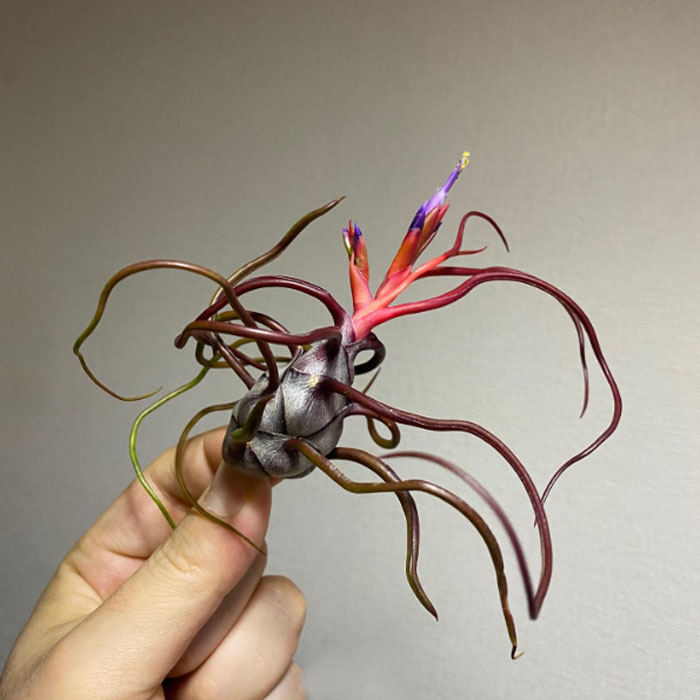
Mesic air plants can survive in moderately humid conditions. They have smooth and curly leaves that absorb moisture and air nutrients. It is best to provide these plants with bright, indirect, or filtered light, maintain moderate temperatures, and ensure high humidity levels. They also require more watering than Xeric air plants.
They have roots that help them attach to tree branches or other surfaces. The word “mesic” comes from the Greek word “mesos,” which means “middle” or “intermediate.” Some examples of Mesic air plants are:
How Do You Take Care of Air Plants? Complete Guide for Air Plant Care
Image credits:airplantdesignstudio.
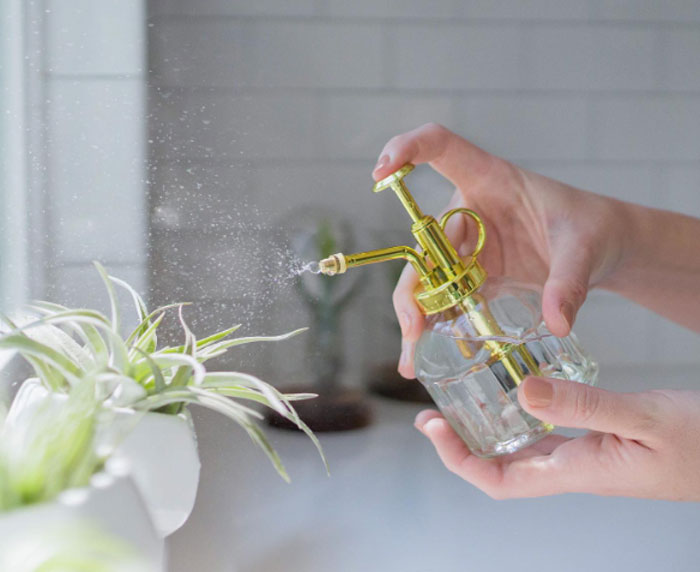
Although these home flowers are low-maintenance, they will need a little attention, so you must still follow the essential steps to caring for air plants. To make them bloom and thrive, you must know how to water air plants and ensure they have enough moisture. We will share all the tips on how to care for air plants’ light, temperature, fertilizer, and blooming needs.
How Often Do You Water Air Plants?
Watering frequency depends on several factors, such as the type of air plant, the temperature, the humidity, and the light levels. Generally, most air plants need to be wateredonceevery1 to 2 weekswhen grown in typical household conditions. However, some air plants may prefer more or less water than others.
As mentioned, Xeric air plants are adapted to dry environments. They may need less frequent soaking than Mesic air plants adapted to humid climates. How to water air plants? The best method to use depends on your air plant type, but there are three ways:
Do You Need to Fertilize Your Air Plants?
Yes, you do need to fertilize your air plants, but only sometimes. To begin, make sure to use the right type of water when watering them. The best water for air plants is rainwater, pond water, or aquarium water because they all contain some nutrients that benefit the plants.
What Kind of Lighting Conditions Air Plants Require?
Generally, air plants need bright, indirect light or filtered sunlight, mimicking the light conditions in their native habitats. However, some air plants, like Xeric from drier or desert-like habitats, can tolerate direct sunlight. On the other hand, Mesic air plants do better with indirect sunlight. They come from moist or shady habitats, such as rainforests. Although indirect light is usually preferred, the air plants can tolerate more direct light in the winter due to the lower sun angle.
Position your air plants approximately3 feet away from east or southeast-facing windows for best results. You can provide enough light to your air plants using artificial lights like fluorescent bulbs or LED lamps. Make sure to keep them at least 12 inches away from the light sourceand provide them with10 to 12 hours of sunlight per day.
What Temperature Is The Best For Air Plants?
The ideal temperature range for air plants is65-85°F (18-29°C)as they thrive in warm and humid environments. However, certain air plant species may be able to tolerate lower or higher temperatures based on their type and origin.
Xeric air plants with silver or gray leaves can tolerate higher temperatures and lower humidity. Mesic air plants with green leaves prefer cooler temperatures and higher humidity. Keeping your air plants within a temperature range of45-95°F (7-35°C)is essential to avoid damage or potential death.
Where Should I Put an Air Plant? Styling Them Into the Interior
One of the best things about air plants is that they are very versatile and easy to style into your interior. You can put them almost anywhere with enough light, air, and water. You can display them creatively, such as hanging them from the ceiling, attaching them to the wall, placing them on a shelf, or arranging them in averticle garden.
Mix and match various air plants to create a stunning visual effect. Air plants can complement any style of decor, from modern to rustic, minimalist to eclectic. They can add a touch of nature and freshness to your room, making it more lively and inviting. Let’s explore some ideas for styling air plants into your interior and making them look amazing.
Glass Terrarium
Image credits:Nielsen Ramon.

Using a glass terrarium, you can create a miniature garden for your air plant. With a glass terrarium, you can see your air plants from all angles and add decorative elements such as pebbles, moss, or rocks. You can select various shapes and sizes of terrariums, including glass globes, cubes, or pyramids. Additionally, you can let your creativity flow and make your ownDIY coffee pot terrariumfor your plants.
Hanging Air Plants
Image credits:airplantshop.nl.

Hanging air plants is a great way to display and show off these unique and beautiful plants. As air plants can attach themselves to various surfaces, such as wood, bark, wire, or moss, there are many ways to hang them, depending on your preference and creativity. You can use boho macrame hangers and otherartsy planters.
Handmade Concrete Planters
Image credits:Alena Darmel.
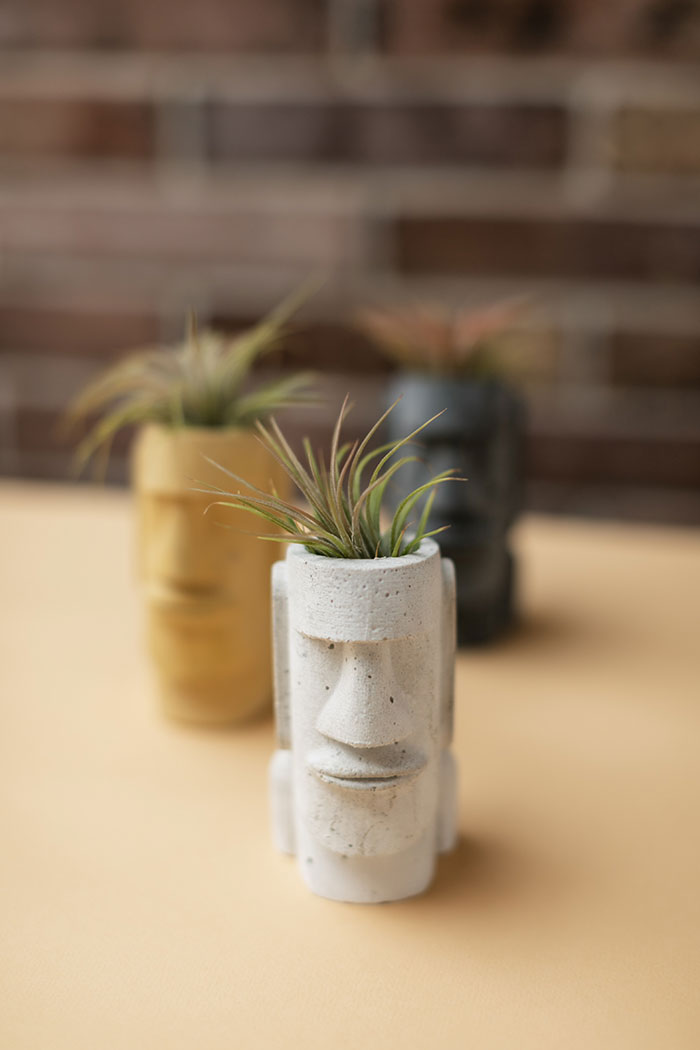
Those who want to put the icing on the cake in their interior need unusual andcreative plant pots. You can design mini concrete planters to display your air plants on a table, shelf, or windowsill. Concrete planters are durable and modern; you can make them with rainbow-colored layers. Remember, you don’t need to add soil or water to the planter, as air plants only need air and light to grow.
Seaside Shells
Image credits:cactus.mru.

Would you like to give your home a coastal vibe? Consider using seashells as holders for your air plants! Seashells have a natural and stunning appearance that can complement the shape and color of your air plants. You could place them on a tray, a bowl, or a glass jar. Alternatively, you could glue them to a driftwood or a wreath. This will add a touch of the beach to your home decor, adding a new, eye-catching display.
Sculptural Wood Holders
Image credits:goodsmithshop.
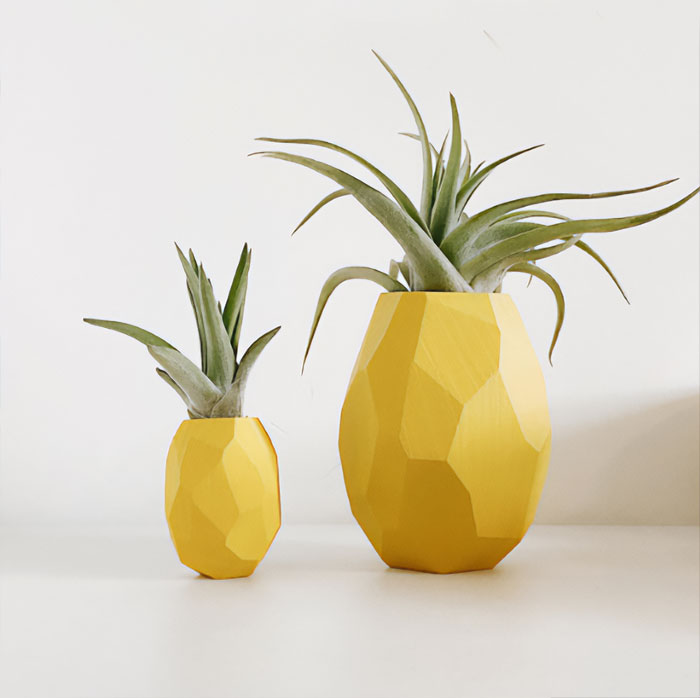
You can use a sculptural wood holder to display your air plant in a minimalist and elegant way. Sculptural wood holders are made from natural or reclaimed wood carved, shaped, or decorated to create unique and beautiful forms. You can place it on a desk, a nightstand, or a coffee table.
Air Plant Magnets
Image recits:gohug_a_cactus.
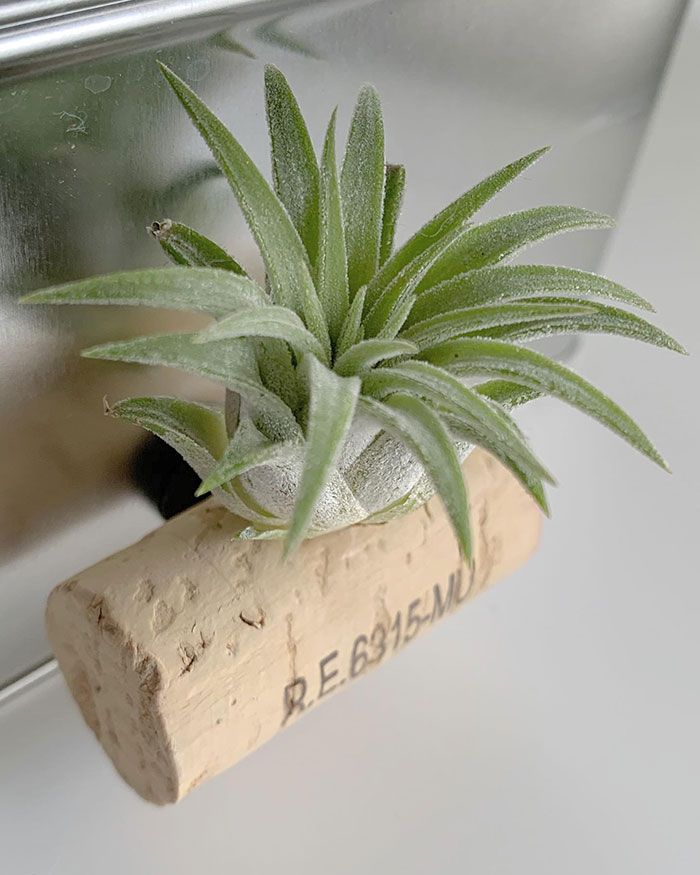
Do you have a bunch of magnets on your fridge door? Add a new air plant magnet to your collection. They are small magnets that can securely hold air plants on a metal surface, allowing you to display them in various ways. You can find many air plant magnets to buy or get inspired to make your own.
Any Doubts? We Are Happy to Solve Them!
We previously discussed how to care for air plants’ needs. Even though they are not difficult to maintain, they can still encounter typical issues. If you have any lingering uncertainties, we would be delighted to address them.
Can Overwatering Lead to Rotting?
Although air plants are easy to care for, you must ensure they dry out entirely after soaking or misting them. The signs of overwatering or rotting are:
To prevent this, you have to know how to water air plants. To avoid overwatering, shake off any excess water and let the plant dry completely before putting it back in its place.
Can Underwatering Lead to Drying Out?
This can happen when the air plants do not receive enough water or humidity. The signs of underwatering or drying out are:
You can also check the leaves of your air plants for signs of thirst. The plant needs moisture if the leaves curl inward along their length. If the leaves feel limp, the plant is dehydrated and needs water.
Can Air Plants Sunburn or Scorch?
Appropriate air plant care is essential to prevent this. Place your air plants in bright but indirect light, and avoid harsh sun rays that can burn their leaves.
Can Air Plants Have Pests or Diseases?
To prevent this, inspect your air plants regularly for any signs of pests or diseases and treat them with insecticidal soap, rubbing alcohol, or neem oil.
How Long Can Air Plants Live?
Air plants can survive for years, depending on the species and environment. Some factors that affect their lifespan are light, temperature, humidity, air circulation, and watering frequency.
The average lifespan of air plants is between 2 to 5 years. However, some species can live much longer, up to 20 years or more. For example, Tillandsia xerographica, a large and slow-growing air plant, can live for up to 20 years with proper care.
812views812views
You May LikePeople Are Sharing Their Decked-Out Bedrooms, And Here Are 30 Of The Most Amazing OnesŽydrūnė TrukanavičiūtėSnake Plant Care Guide & Tips For A Thriving PlantFranka Dervishi
Žydrūnė Trukanavičiūtė
Franka Dervishi
Home & Design